Contents
It is the mock orange for residents of regions with a harsh climate that is associated with genuine jasmine, although, in fact, it has nothing to do with this culture. This ornamental, flowering shrub, popularly called garden jasmine, conquers with the luxury of delicate flowering and the fragrance of a subtle, heady aroma. Planting and caring for a mock orange does not require much effort and labor, but it can become a true highlight of every garden plot. Despite the endurance and unpretentiousness, the successful cultivation of garden jasmine is possible only if certain agricultural practices are observed.
Features of growing mock orange
All types of mock oranges, without exception, are deciduous, ornamental shrubs with pale green foliage, changing their color by autumn, and snow-white flowering of double, semi-double or simple flowers. The basic rules for planting and caring for garden jasmine, so that it, just like in the photo, pleases with its lush flowering, are as follows:
- mock orange is very light-loving, therefore, even in openwork penumbra, its shoots stretch out, become weak, and flowering is scarce and rare;
- grows well and fully reveals its decorative qualities only on fertile, loose, permeable soils;
- heat-loving varieties of mock orange do not tolerate cold winds and drafts;
- does not tolerate garden jasmine waterlogging, swampy and saline soils with a close occurrence of groundwater;
- the rapid growth of young shoots and the rapid annual growth of branches forces gardeners to regularly prune, which the mock orange tolerates easily.
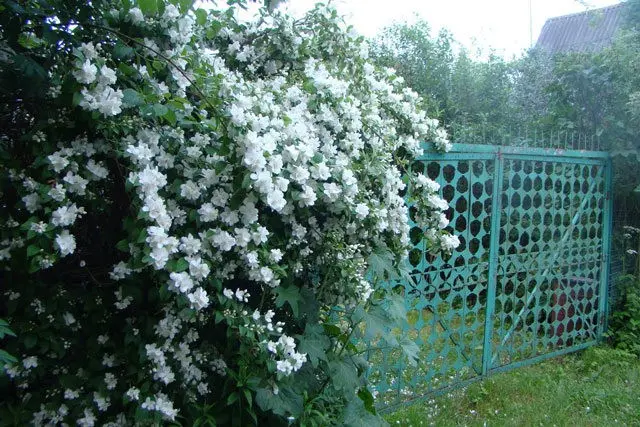
How to plant a mock orange
Grow garden jasmine as single or group plantings, as well as to create hedges. For single specimens, they dig a planting hole 50×50 cm in size and 60 cm deep, for a hedge, the distance between the holes is left 0,6-0,7 m. In group plantings of garden jasmine, the distance is increased to 1,5 m. varieties – tall or short mock orange will grow in the garden. Seedlings are planted until the leaves bloom, otherwise they may not take root and die.
When to plant mock orange
Mock orange is planted in early spring – in the middle or last decade of April, and also in autumn – from mid-September to mid-October. Autumn planting is suitable for southern regions with a mild climate and not harsh winters. However, garden jasmine seedlings planted in autumn show the best survival rate. Work on planting mock orange in spring and autumn is no different from each other. The main thing is to observe the planting dates so that the root system of garden jasmine can quickly adapt and grow stronger. In the spring, landing is carried out at least 2 weeks before the onset of stable heat – until the buds have blossomed. In autumn – at least a month before the cold weather, so that the root system of the mock orange has time to take root in a new place and safely overwinter.
Where to plant a mock orange
The planting scheme for the mock orange depends on the landscape project, but in order for the shrub to look like in the photo above, you need to choose a well-lit, sunny place. On the north side, the site should be protected by a wall of a house or building, a fence, a hedge or large trees. The ideal option would be the south side of any building with protection from the cold north winds, surrounded by other flower and perennial crops. Decorative jasmine feels good on a small hill, where groundwater lies very deep.
What can be planted next to the mock orange
Any flowering shrubs, perennials and annuals will be good neighbors of the mock orange. Compositions of garden jasmine with spirea, weigela, hydrangea, lilac, decorative apple tree look great. Next to the imaginary jasmine, you can also plant any tree species with unusual leaves or crowns – maple, hazel, derain, which will become an excellent backdrop for the lushly flowering mock orange. In flowerbeds and flowerbeds, mock orange gets along well with any flowers: annuals or perennials, deciduous and ornamental plants. The composition with roses and peonies looks incredibly chic, the bright beauty of which harmoniously emphasizes the delicate, romantic flowering of mock orange.
In addition, in landscape design, garden jasmine is used to decorate alleys or decorate a themed garden, as well as for a symmetrical geometric pattern in a specific area of uXNUMXbuXNUMXbthe backyard. If you follow all the recommended measures when planting and caring for a shrub, the mock orange, surrounded by other flower crops, will look the same as in the photo.
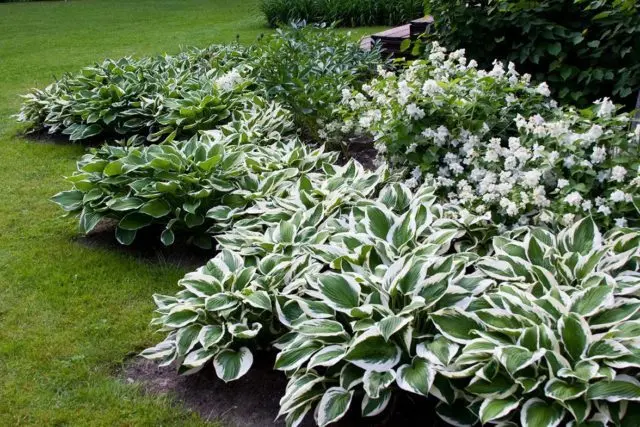
What kind of soil does the mock orange like
Regardless of the timing of planting mock orange – in spring or autumn – for successful cultivation, it needs fertile, loose soil. To prepare a fertile mixture, leaf soil, humus and sand are mixed in a ratio of 3: 2: 1. A drainage layer is required, which may consist of sand, rubble or broken bricks, since the root system of garden jasmine is not resistant to rot.
How to plant mock orange
After preparing the soil and planting pits, they begin to plant the mock orange. At the bottom of the pit, drainage is poured with a layer of at least 20 cm, then a small part of the fertile soil. The seedling is set so that its root neck is located at ground level. Its slight penetration of no more than 2 – 3 cm is allowed. If you do not follow these standards, then the roots will soon rot.
How to transplant garden jasmine
In some cases, the mock orange requires a transplant to a new place. This need arises for various reasons. For example, you need to make room for other cultures, or initially a site was chosen incorrectly for jasmine, where it does not develop actively enough. Perhaps the terrain has changed, and the site has become flooded, or a building has appeared that blocks the sunlight. There can be many reasons, however, without unnecessary need, an adult plant should not be transplanted. Often a transplant is also required for planting a bush. At a young age, garden jasmine tolerates movement more easily, having natural forces for recovery and growth. A shrub older than 8 years may not take root at all.
When transplanted mock orange
Most often, gardeners transplant mock orange in the fall – in early or mid-October. It is unacceptable to transplant the plant in the summer, especially during flowering. In some cases, a change in the place of cultivation is performed in the spring – in late March or early April, before bud break and sap flow begins. Spring transplant is similar to autumn. However, it should be understood here that after this, garden jasmine will need a lot of time to recuperate and accumulate nutrients so that it can get stronger and take root well.
How to transplant a mock orange to a new place
The stages of work during the transplantation of an adult mock orange bush are as follows:
- carry out pruning of excess, old, dry, weak branches and shoots that thicken the bush;
- with the help of a rope, the branches of the bush are fastened together;
- abundantly water the bush with 5 – 6 liters of water to completely soften the soil;
- carefully dig around the near-trunk circle of jasmine, retreating from the trunk by 30 cm, extracting without damaging the roots with an earthy clod;
- pre-prepare a new planting hole, the size of which should be slightly larger than the size of the mock orange root system;
- at the bottom of the pit, a layer of drainage and fertile soil is placed with 2 handfuls of wood ash and the addition of superphosphate;
- the pit is watered with 1 bucket of water with a root-stimulating solution dissolved in it;
- install a transplanted jasmine bush and sprinkle it with earth;
- the soil is compacted and abundantly shed;
- the trunk circle is mulched with needles, sawdust or fallen leaves;
- ropes are removed from the branches of jasmine.
Seedlings, in view of their young age, are much easier to transplant. It is performed in the same way as for adult plants. Subsequent care for the mock orange in autumn or spring is carried out according to the standard scheme.
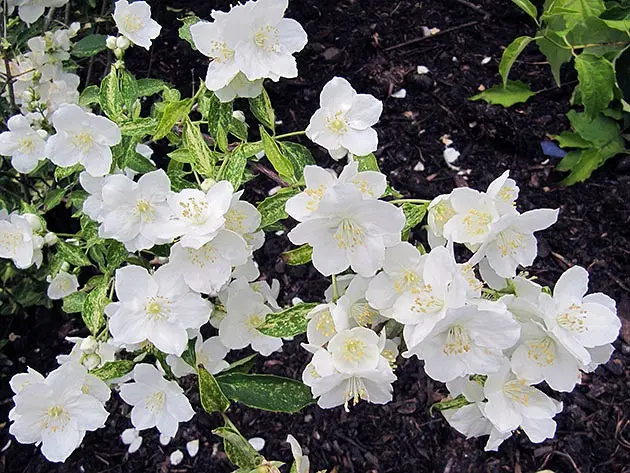
How to plant a mock orange
The process of planting a mock orange bush is similar to transplanting. However, unlike it, such an event allows you to get new planting material. The timing of the procedure is the same as for transplantation. The excavated bush is carefully freed from excess earth, and the roots are washed if necessary. With the help of a sharp knife or secateurs, they are divided into several parts, making sure that several strong growths with healthy buds remain on each division. The ends of the branches and roots are slightly pruned. Planting of renewed seedlings is carried out similarly to the method described above with preliminary preparation of planting pits, drainage and fertile soil. The deepening of seedlings is carried out to the upper pair of buds, the earth is compacted and shed abundantly. Do not forget when transplanting or planting garden jasmine and about mulching.
Only young jasmine shrubs are suitable for planting, the old ones simply cannot cope with reproduction in this way and will not take root in a new place. The resulting planting material is planted in accordance with all requirements for the cultivation of mock orange. If individual roots are damaged during operation, they must be removed, and the cut should be treated with charcoal powder. Some time after the transplant, they are engaged in the formation of a bush of garden jasmine and giving the crown a neat, symmetrical look.
How to care for a mock orange
When growing a mock orange, caring for it consists in the following agricultural techniques:
- regular watering and top dressing in spring, summer and autumn;
- weeding from weeds, loosening and mulching of the trunk circle;
- sanitary and formative pruning in early spring and after flowering;
- measures to prepare the plant for the winter period;
- preventive measures against pests and diseases, treatment with agents for detected diseases or pests.
Watering Schedule
Mock orange is a rather moisture-loving culture, especially during the flowering period. However, as mentioned above, in no case should it be flooded and waterlogged the soil. The optimal schedule would be a weekly single watering with warm, settled water in the amount of 2-3 buckets per 1 adult bush. During a drought, the rate is increased to 2-3 times a week.
Top dressing mock orange
When planting a mock orange in spring or autumn in open ground, additional feeding is not required, since the fertile soil contains all the nutrients necessary for the normal growth and development of the plant. Starting from the second year of planting, the plant is used:
- organic fertilizers – they are applied in early spring in the form of slurry diluted with water in a ratio of 1:10 or in the form of rotted manure directly into the soil of the near-stem circle of decorative jasmine;
- solution of complex mineral fertilizers – they are watered with mock orange before flowering from the 3rd year of planting: 1 g of superphosphate, 20 g of urea and potassium sulfate are taken for 15 bucket of water;
- top dressing with mineral fertilizers – repeat after flowering, timing it with the formative pruning of garden jasmine.
Loosening and mulching the soil
Loosening to saturate the soil with oxygen and maintain it in a light, waterproof state is mandatory when growing mock orange. Loosen the soil to a depth of 10 cm 3 – 4 times per season. After that, the trunk circle of jasmine is mulched with fallen leaves, peat or humus. This measure allows you to retain moisture, avoiding the drying of the upper layers of the soil. In addition, mulching provides additional nutrition to garden jasmine, improving fertility and soil composition. Caring for mock orange in the fall necessarily includes mulching, which in winter will provide an additional guarantee of the safety of the root system of the crop from frost.
Preparing the mock orange for winter
Garden jasmine tolerates winter well in the middle lane without additional shelter. However, the frost resistance of the culture depends on the specific species. So, some varieties of mock orange perfectly tolerate temperature drops to 25 degrees below zero, others do not freeze only up to 15 degrees below zero. Therefore, when buying seedlings, it is necessary to clarify the winter hardiness of a particular variety.
Preparation for the winter of the mock orange begins before the onset of frost. The soil of the trunk circle is loosened deeply, destroying weeds, and mulched with a thick layer of humus, peat or fallen leaves. If necessary, cover the decorative jasmine shrub with burlap or other light, non-woven material, tying it with ropes. Young plants, whose age does not exceed 1 year, need enhanced protection from the cold. They must be covered for the winter, during the entire cold period they make sure that there is not very much snow cover on the bushes, since a large layer of snow can break the bushes. In spring, the entire snow cap is removed from all garden jasmine shrubs.
More information about planting, transplanting and caring for the king of domestic gardens – mock orange, or garden jasmine – in a useful video:
Pests and diseases of mock orange
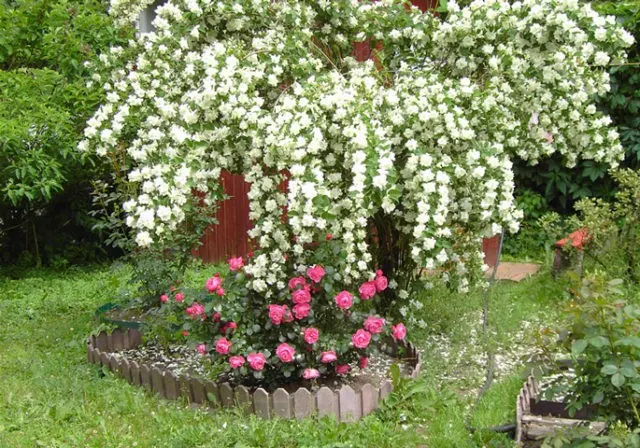
In order for the mock orange to please with its decorative effect for a long time, as indicated in the description and shown in the photo, immediately when planting a shrub, it is necessary to carry out preventive treatment against diseases and pests. To do this, use the approved means for spraying exactly the garden jasmine – Fufanon, Hom. Preventive spraying is best done during bud swelling, before and after flowering.
Most varieties of mock orange are resistant to pests and plant diseases. However, with improper care or adverse conditions, garden jasmine is affected:
- fungal diseases – gray rot and septoria spotting;
- aphids;
- spider mite;
- weevil.
To combat them, insecticides are used immediately after being found on jasmine bushes. In order for pests and diseases to bypass the mock orange, fallen leaves are removed in a timely manner, old, dry branches are cut off, preventing thickening, regular watering and feeding are provided. If false jasmine is placed near crops prone to the same diseases and pests, then preventive treatment is done for all plants at the same time.
In the photo of the picturesque composition there is a mock orange bush with other flowering plants that match each other in terms of description, growing conditions and planting rules.
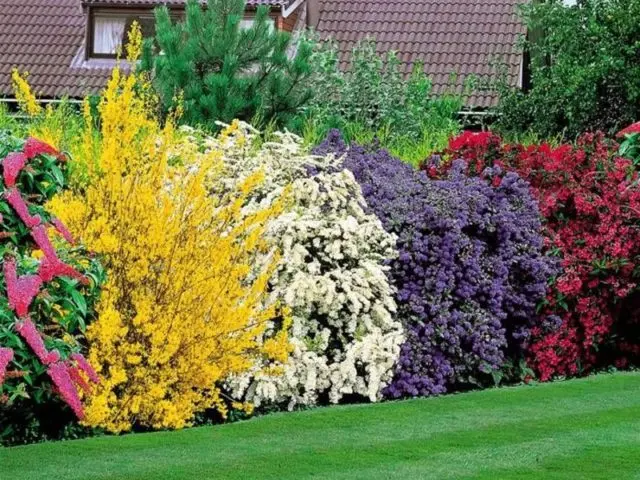
Conclusion
Planting and caring for mock orange – this unpretentious and hardy culture – are simple activities that even a beginner can handle. And this will help knowledge of agricultural technology of plant transplantation.









